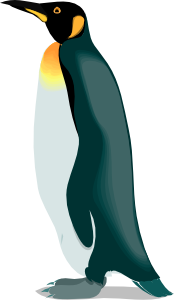Emperor penguins in Antarctica

Emperor penguins have special physical and behavioural features that help them survive in cold climates, e.g., Antarctica.
For the following questions, explain how each adaptive feature helps the penguin keep warm in a very cold climate.
Investigating the adaptations of Emperor penguins covers a number of important principles that are relevant to a wide range of adaptive solutions that have evolved in different environmental situations. The extreme conditions in Antarctica provide a focus for exploring features that enable them to survive there.
Because Emperor penguins are likely to be unfamiliar to many students, a shared experience before investigating their adaptations will provide a common point for discussion. Video clips are a good way of hooking students into thinking about adaptations. Refer to Furtherresources.
|
|
Adaptive feature and how it helps the penguin survive |
Y10 (04/2005) |
|
|
i) |
Layer of blubber
|
moderate best answer - difficult
|
|
|
ii) |
Feathers are short and overlap to keep water out
|
easy
best answer - difficult
|
|
|
iii) |
Underneath the outer feathers is a layer of down
|
difficult
best answer - very difficult
|
|
|
iv) |
Large body size
|
difficult
best answer - very difficult
|
|
|
v) |
Huddle together in groups
|
moderate
best answer - very difficult
|
|
|
vi) |
Take turns to be on the outside of the group
|
easy
best answert - very difficult
|
|
|
vii) |
Can balance on the backs of their heels and tails
|
very difficult
|
|
|
viii) |
Feathers cover their knees
|
difficult
best answer - very difficult
|
|
- Trial students found it difficult to identify how the adaptations kept penguins warm.
- One exception was huddling in groups, which is a behavioural rather than physical adaptation. Possibly this was easier because they had experienced it themselves.
- Students also had difficulty with explaining the adaptation in terms of scientific principles. One exception was blubber, where more students (52) made reference to insulation than didn't (27).
Putting the pieces back together
- Encourage students to consider the whole system. Penguins need all these adaptations. They work together.
- Encourage students to think beyond specific examples. Identify some of the principles of adaptations at work in other environments and species. What adaptive strategies do they have to survive the temperatures they live in?
|
Big idea Surface-area to volume ratio: The larger the animal, the smaller the surface-area: volume ratio and so the less relative area there is to lose heat. Adaptations Large body size Huddle together in groups Activities Investigation:
Discussion:
Related idea: |
|
Big idea Heat transfer: Penguins have adaptations that insulate their bodies to slow down loss of body heat. Adaptations Layer of blubber Feathers are short and overlap to keep water out Underneath the outer feathers is a layer of down Feathers cover their knees Activities Fat/blubber is an insulating material Demonstration:
Questions to ask:
Possible misconception: |
|
Big idea
Layers of air act as insulation.
Discussions:
Investigations:
|
|
Big idea
Water/moisture cools the body.
Discussion
Ask students to recall their own experiences, for example, at the beach in the wind before and after swimming.
Questions to ask:
The discussion can be extended to:
Related idea: |
|
Big idea:
|
|
Big idea: |
- Ministry of Education (2003). Building Science Concepts Book 47, Insulation. Wellington: Learning Media.
- Ministry of Education (2003). Building Science Concepts Book 36, Heat on the move. Wellington: Learning Media.

